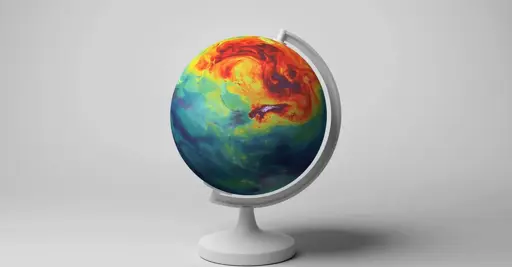- cross-posted to:
- collapse@lemm.ee
- cross-posted to:
- collapse@lemm.ee
Global warming is moving faster than the best models can keep a handle on
Weren’t there a whole bunch of hot models that were discarded becase they were “too scary” ?
The solution is obviously to build a giant computer that will consume enough power that it will double our CO2 emissions ! /sarcasm, yes.
When South Miami floods (due to Climate-change induced rising seas), they pump out the water with fossil fuel powered pumps.
When the (climate change induced) droughts caused the blackouts in South America this year, people bought gasoline generators and burned fossil fuels on a massive scale to keep their lights on.
/not sarcasm. This is the world we live in.
Well you’d have to keep in mind those new AI systems will tell us the solution to global warming!
We will go like: “Hello ChatGPT, how can we prevent global warming?” And it will go like: “Dude wth, turn off all these power hungry AI systems, are you stupid?” Us: “And go back to creating my own PowerPoints? No thank you, any other solution?” Chat: “Well maybe stop this insane consumption rate? Do people really need all this junk? Make stuff that lasts and don’t replace it all the time.” Us: “Nah man, we need to consume otherwise the profits will go down. You see number must always go up.” Chat: “Well I see a very lobsided distribution of wealth and resources. If you could free up those resources, you could perhaps soften some of the impact of global warming.” Us: “Give up my monies? We can’t give up the monies, it is precious to us.”
Alright guys, this model also has no clue how to fix global warming, must not be smart enough. Get that new model training ASAP, it needs to be at least twice as big. And maybe if we power it through coal instead of green energy, it will have an understanding of global warming in its soul.
This whole article boils down to one thing. We know that the earth is warming and is going to continue warming but we can’t model the effects on a local scale. The problem is simply too complex for our current models and our current computing infrastructure.
The absolute best climate models have horizontal resolutions on the order of 10km. That means that there is one value for temperature every 10km, one value for water vapor every 10km, one value for north-south wind speed every 10km, one value for east-west wind speed every 10km.
Of course we can’t model hyper local climate effects! We have one pixel every 10km to help us understand an immensely complex system and how it is changing over hundreds of years!
Hell, we can barely model hyperlocal weather effects! We have high resolution satellite measurements every 10 minutes over the entire globe. We know where everything is and can give the models very good initial conditions. Yet we still can’t say whether it will snow in your neighborhood tomorrow. We can give a probability, but nothing certain.
If, given high resolution initial conditions for modeling weather, we can’t model a neighborhood’s weather accurately, why would anyone think we can accurately model hyperlocal climate effects?
Source: A drunk atmospheric scientist
Full article:
Fifty years into the project of modeling Earth’s future climate, we still don’t really know what’s coming. Some places are warming with more ferocity than expected. Extreme events are taking scientists by surprise. Right now, as the bald reality of climate change bears down on human life, scientists are seeing more clearly the limits of our ability to predict the exact future we face. The coming decades may be far worse, and far weirder, than the best models anticipated.
This is a problem. The world has warmed enough that city planners, public-health officials, insurance companies, farmers, and everyone else in the global economy want to know what’s coming next for their patch of the planet. And telling them would require geographic precision that even the most advanced climate models don’t yet have, as well as computing power that doesn’t yet exist. Our picture of what is happening and probably will happen on Earth is less hazy than it’s ever been. Still, the exquisitely local scale on which climate change is experienced and the global purview of our best tools to forecast its effects simply do not line up.
Today’s climate models very accurately describe the broad strokes of Earth’s future. But warming has also now progressed enough that scientists are noticing unsettling mismatches between some of their predictions and real outcomes. Kai Kornhuber, a climate scientist at Columbia University, and his colleagues recently foundthat, on every continent except Antarctica, certain regions showed up as mysterious hot spots, suffering repeated heat waves worse than what any model could predict or explain. Across places where a third of humanity lives, actual daily temperature records are outpacing model predictions, according to forthcoming research from Dartmouth’s Alexander Gottlieb and Justin Mankin. And a global jump in temperature that lasted from mid-2023 to this past June remains largely unexplained, a fact that troubles Gavin Schmidt, the director of NASA’s Goddard Institute for Space Studies, although it doesn’t entirely surprise him.
“From the 1970s on, people have understood that all models are wrong,” he told me. “But we’ve been working to make them more useful.” In that sense, the project of climate modeling is a scientific process that’s proceeding normally, even excellently. Only now the whole world needs very specific information to make crucial decisions, and they needed it, like, yesterday. That scientists don’t have those answers might look like a failure of modeling, but really, it’s a testament to how bad climate change has been permitted to get, and how quickly.
The Earth is an unfathomably complex place, a nesting doll of systems within systems. Feedback loops among temperature, land, air, and water are made even more complicated by the fact that every place on Earth is a little different. Natural variability and human-driven warming further alter the rules that govern each of those fundamental interactions.
Some of these systems—such as cloud formation—are notoriously poorly understood, despite having a major bearing on climate change. And, like clouds, many parts of the Earth system are just too localized for climate models to pick up on. “We have to approximate cloud formation because we don’t have the small scales necessary to resolve individual water droplets coming together,” Robert Rohde, the chief scientist at the open-source environmental-data nonprofit Berkeley Earth, told me. Similarly, models approximate topography, because the scale at which mountain ranges undulate is smaller than the resolution of global climate models, which tend to represent Earth in, at best, 100-square-kilometer pixels. That resolution is good for understanding phenomena such as Arctic warming over decades. But “you can’t resolve a tornado worth anything,” Rohde said.
Models simply can’t function on the scale at which people live, because assessing the impact of current emissions on the future world requires hundreds of years of simulations. Modeling the Earth at one-square-kilometer pixels would take “like a hundred thousand times more computation than we currently have,” Schmidt, of NASA, told me. Still, global climate models can be of local use if combined with enough regional data and the correct expertise, and more people now want to use them that way, in order to understand risk to their properties and investments, or to make emergency plans and build infrastructure. “We are asking a lot of the models. More than we have in the past,” Rohde said.
For nonscientists, coaxing useful information from climate models requires professional help. Climate scientists have been working for years with New York City to help direct choices such as where to put infrastructure with sea-level rise in mind. But, Schmidt said, “there’s just not enough scientists to be on the advisory board of every locality or every enterprise or every institution or every company,” helping them access the right climate data or pick which models to rely on. (Some are better at simulating certain variables, such as day-to-night temperature variation, than others.) Often governments end up turning to private-sector companies that claim to be able to translate the data; Schmidt would rather see his own field produce work that is more directly useful to the public.
At the same time, now that the models are running up against the reality of dramatic climate change, some of their limits are showing. When this scientific endeavor first started, the models were meant to imagine what global temperatures might look like if greenhouse-gas emissions rose, and they did a remarkable job of that. But models are, even now, less capable of accounting for secondary effects of those emissions that no one saw coming, and that now seem to be driving important change.
Some of those variables are missing from climate models entirely. Trees and land are major sinks for carbon emissions, and that this fact might change is not accounted for in climate models. But it is changing: Trees and land absorbed much less carbon than normal in 2023, according to researchpublished last October. In Finland, forestshave stopped absorbing the majority of the carbon they once did, and recently became a net source of emissions, which, as The Guardian has reported, swamped all gains the country has made in cutting emissions from all other sectors since the early 1990s. The interactions of the ice sheets with the oceans are also largely missing from models, Schmidt told me, despite the fact that melting ice could change ocean temperatures, which could have significant knock-on effects. Changing ocean-temperature patterns are currently making climate modelers at NOAA rethink their models of El Niño and La Niña; the agency initially predicted that La Niña’s cooling powers would kick in much sooner than it now appears they will.
Biases in climate models go in both directions: Some overestimate risk from various factors, and others underestimate it. Some models “run hot,” suggesting more warming than what actually plays out. But the recent findings about temperature extremes point in the other direction: The models may be underestimating future climate risks across several regions because of a yet-unclear limitation. And, Rohde said, underestimating risk is far more dangerous than overestimating it.
To Kornhuber, too, that models already appear to be severely underestimating climate risk in several places is a bad sign for what’s ahead and our capacity to see it coming. “It should be worrying that we are now moving into a world where we’ve kind of reached the limit of our physical understanding of the Earth system,” Kornhuber said.
While models struggle to capture the world we live in now, the planet is growing more alien to us, further from our reference ranges, as the climate keeps changing. If given unlimited time, science could probably develop models that more fully captured what we’re watching play out. But by then it would be too late to do anything about it. Science is more than five decades into the modeling endeavor, and still our best tools can only get us so far. “At the end of the day, we are all making estimates of what’s coming,” Rohde said. “And there is no magic crystal ball to tell us the absolute truth.” We’re left instead with a partial picture, gestural in its scope, pointing toward a world we’ve never seen before.
Suggested music to read the article to:
Welcome to the polycrisis.
‘Humans, a polycrisis’
Okay, I’ll do it.
Unchecked greed.
Maybe China needs to restart pumping out SO2 emissions again! /s
You may joke but there are some people saying we neex to geo-enginner our way out of this mess by constantly and endlessly inject SO2 into the upper atmosphere. They absurdly claim this will bu us time to suck off oir CO2 emissions and hide them.
Apparently serious people believe this shit. I guess people will grasp at any straw to avoid riding a bicycke and not flying.
I think this will start happening when whole countries start to feel the final existential pressure. Places like Pakistan, India and Brazil.






